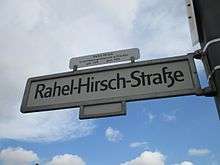Rahel Hirsch
Rahel Hirsch (September 15, 1870 – October 6, 1953) was a German physician and professor at the Charité medical school in Berlin. In 1913 she became the first woman in the Kingdom of Prussia to be appointed a professor in medicine.[1]
.jpg)
_Rahel_Hirsch.jpg)

Biography
Rahel Hirsch was born on 15 September 1870 in Frankfurt am Main, one of eleven children of Mendel Hirsch (in German) (1833–1900). Mendel Hirsch was the director of the girls' school of the Jewish religious community in Frankfurt am Main. Mendel's father, Rahel's paternal grandfather, was the eminent rabbi Samson Raphael Hirsch
From 1885 to 1889, Rahel Hirsch studied for her degree in education in Wiesbaden; she then worked until 1898 as a teacher. The German Reich did not permit women to study medicine so she studied in Zurich, Switzerland. In 1899 she continued to study in Leipzig, Germany and Strasbourg, France to earn her medical doctor title in 1903.
In 1906, Rahel Hirsch was the first scientist to find the presence of starch granules in the blood and urine. She found that tiny cells, no more than 0.2mm, could penetrate the kidneys and be removed by the urine. She was mocked at a meeting of the Society of the Charité's Directors and her research was ignored since the doctors believed they knew more than her. She was unable to convince them otherwise. However, in 1957, G. Volkheimer, an assistant at Charité, came across her work and publicized it, naming it the "Hirsch Effekt."[2]
She was then hired to work at the Medical Clinic of the University of Berlin at the Charité as an intern. The Charité was militarily strong and she was the second female to ever be hired here. Hirsch worked as an assistant to the physiologist Professor Friedrich Krause. [3] Rahel Hirsch worked along surgeon Ernst von Bergmann and anatomist Wilhelm von Waldeyer-Hartz. [2]
In 1908, Hirsch was appointed head of the polyclinic at the Charité's Medical Clinic, however, she was never a paid employee here. After being replaced, she left the Charité and started her own internal medicine practice in Berlin. [3] At her private practice, she had modern x-ray equipment and wealthy clientele that allowed her to live comfortably. [2]
Rahel Hirsch was the first female to be awarded the title of Professor in Prussia in 1913. [3]
In 1914, Hirsch published a study titled “Accidents and Internal Medicine.” [3]
Rahel Hirsch was a Jewish Woman which prohibited her from teaching. She went on to write a treatise titled the "Physical Culture of Women." [3] She wrote to counter the medical prejudice against physical activity for women and favored naturally-fitting clothing. Hirsch tried to bring attention to women’s public health by raising awareness about hygiene, nutrition, and physical strengthening. In an article published in the Munich Medical Weekly, she writes to her male colleagues to not look at women from just the point of view of a gynecologist. She also argued that women’s inferiority to men due to their biologically determined lighter brains was not true. She stated that women’s physical and psychological weakness compared to men came from a faulty upbringing. [2]
As Jewish persecution by the Nazis gathered momentum, Hirsch lost her professional opportunities, culminating in the cancellation of her license to practice medicine in 1938. When she learnt that she was about to be arrested, she escaped to England at 68 years old. In England, Hirsch could not practise as a doctor. Instead she worked as a librarian and a laboratory assistant. During wartime she lived in Yorkshire and returned to London after the war. Her treatment by the Nazis manifested itself in the form of depression, hallucinations and a persecution-complex. As a result, she was committed to a psychiatric hospital, where she died on October 6, 1953. Hirsch was buried in one of London’s Jewish cemeteries.[2]
Legacy
Her reputation was upheld by G. Volkheimer. Many internal medicine textbooks refer to the “Hirsch Effekt” and the State of Israel honored her by including her in the gallery of Famous Jewish Scientists in Jerusalem. In 1995, a bronze statue of Rahel Hirsch stands in the old lecture hall at the Charité. [3]
Germany issued a postage stamp in 2013 to commemorate the centenary of Rahel Hirsch being appointed as the first female professor of medicine in the Kingdom of Prussia.[4]
A stretch of road in front of the new Berlin Hauptbahnhof now bears her name in recognition of her impact on society.[5][6]
References
- "Fraulein Now Professor. Rachel Hirsch The First Woman Physician To Gain That Title". New York Times. November 16, 1913. Retrieved 2010-07-19.
Unusual honors have been won by Hirsch, who is the first woman physician in Germany to acquire the coveted title of Professor. ...
- Petra, Lindner (27 February 2009). "Rahel Hirsch, 1870-1953". Jewish Women's Archive. Retrieved 17 April 2020.
- "Rahel Hirsch". Charité.
- "100 Jahre Professorentitel Rahel Hirsch". jgiesen briefmarken. March 11, 2013. Retrieved April 17, 2020.
- "Archived copy". Archived from the original on 2013-04-12. Retrieved 2012-12-07.CS1 maint: archived copy as title (link)
External links
| Wikimedia Commons has media related to Rahel Hirsch. |